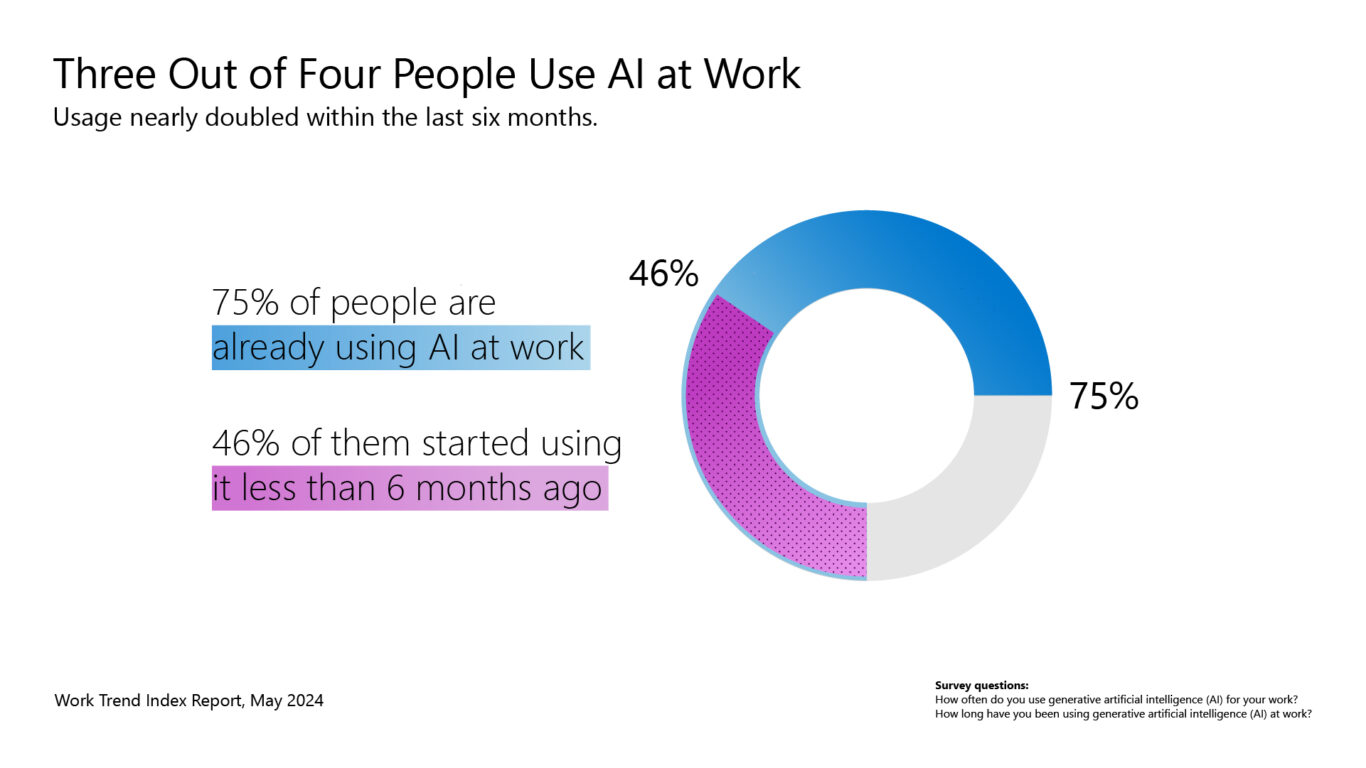Microsoft: Workers are ready for AI, but only 1 in 3 have received training at work
That’s according to Microsoft’s fourth annual ‘Work Trend Index’. Here’s what leading brands are doing to move the needle on AI at work!
News In Brief
Employees are ahead of the game on AI - they are actually bringing their own AI to work if their organization isn't providing it.
This needs to change - and the model to follow is what so-called AI power users and their employers are doing.
Read on to get the inside track.
Three in four workers are using AI at work – that’s according to Microsoft’s fourth annual ‘Work Trends Index’ report.
The tech giant surveyed 31,000 employees globally and found that they don’t see AI as replacing their jobs, but instead helping them do their jobs better.

Microsoft’s data shows that the main gains from AI for workers is that is saves them time (90%), it helps them focus on their most important work (85%), it helps with creativity (84%) and it means they enjoy work more (83%).
This demonstrates that workers are turning to AI to relieve their stress and to help them keep up with the volume and pace of work (68%); 46% of respondents told Microsoft they were burnt out.
In addition, workers see real benefits from AI to supercharge their careers – 68% think AI can help them get promoted faster, 79% said AI broadened their job opportunities.
This links with the fact that AI will create new roles – in fact, two-thirds of those roles on LinkedIn’s Jobs on the Rise list in the US didn’t exist 20 years ago.
The good news is that organizations are on board – Microsoft’s report found that 79% of leaders agree that AI helps businesses stay competitive, and 66% of leaders would not hire someone without AI skills.
The issue is that many employers still don’t have a vision for how to use AI at work (60%), and this means that they will struggle to move from the experimentation stage of AI to true business transformation.
Part of the issue is that “the pressure to show ROI is making leaders move slowly” – this is despite the AI inevitability – that’s according to Colette Stallbaumer, Microsoft copilot GM.
It is clear that “organizations that apply AI to drive growth, manage costs, and deliver value to customers will pull ahead”, stated the report.
But the question that remains is precisely how leaders and organizations need to shift their mindset around AI?
What leaders can learn from AI power users
Microsoft’s report identified AI power users – these workers stand out because of their experimental attitudes towards AI, and their use of AI to really redefine and re-orient how they work (60%).
For instance, 85% use AI to start their day, and get prepared for the following working day.
Of the power users, 92% said AI made their workloads more manageable and boosted creativity, 93% said AI helped them to focus on their most important tasks, while 92% felt more motivated and happy at work.
What also stands out about these super users is they work for organizations and leaders that are supportive, and actively encouraging of their use of AI.
These organizations don’t just focus on hiring AI skills into the organization, but also on upskilling and reskilling their existing talent.
Some of the businesses on LinkedIn’s Top Companies this year are really diving in and offering AI learning opportunities to their teams – stand out examples include JP Morgan Chase, Proctor & Gamble and AT&T.
Across the entire data sample 78% of workers were using their own AI tools at work (rather than company provided ones), just a third said they had gotten AI training from their employer and 45% of leaders admitted to not investing in AI tools for employees.
However, power users were 35% more likely to get tailored training from their employer, they were also 53% more likely to be encouraged to use AI from senior leadership.
According to Microsoft’s report, “AI power users provide a window into the future – revealing what’s possible when employers embrace new ways of working and leaders lean in”.
As well as learning from these power users, Microsoft’s Work Index for 2024 has some other tips and tricks for employers wanting to move the needle on AI and completely transform their businesses in the process.
While a Head of AI, or Chief AI Officer, is emerging as a must-have leadership role – especially as forward-thinking leaders note that the ethical sue of AI at work will be a core part of executives jobs (47%) – Microsoft also calls for organizations to take a dual top-down and bottom-up approach.
By activating teams to experiment and innovate with AI, organizations can really seize the “opportunity ahead to channel employee enthusiasm for AI into business transformation”.
Sign up to the UNLEASH Newsletter
Get the Editor’s picks of the week delivered straight to your inbox!

Chief Reporter
Allie is an award-winning business journalist and can be reached at alexandra@unleash.ai.

